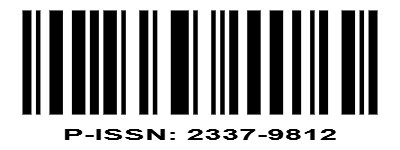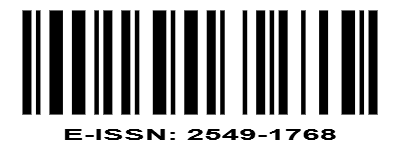COMPOSITION OF ASCOLICHEN IN GAYO HIGHLAND
DOI:
https://doi.org/10.22373/biotik.v9i1.9385Keywords:
Ascolichen, Thallus, Substrate, pHAbstract
Ascolichen is group of lichen composed by ascomycetes (the mycobiont) and algae (the photobiont) species which play ecological and industrial roles. The campus area of Syiah Kuala University Gayo Lues is a part of the Gayo Highland which has specific environmental characteristics. The research aim was to determine the ascolichen species, the type of talus and the substrate characteristics. This study used a qualitative approach with research type was an exploratory survey. Data collection was carried out at 2 stations, namely Station I (campus area) and Station 2 (outside campus area). Data was analyzed descriptively. The results showed that there were 28 species of ascolichen found in the location which belong 3 classis, 6 orders, 15 families, and 25 genera. Moreover, the thallus types of lichen species were crustose (16 species), foliose (8 species), and fruticose (4 species). The types of lichen substrate were tree trunks (22 species), dead woods (9 species) and rocks (4 species). The acidity of the substrates ranges 4-6 (acidic).
Downloads
References
Pratiwi, M. E. (2006). Lichen Study as Air Quality Bioindicator - Case Study: Pulo Gadung Industrial Estate, Cibubur Arboretum and Cikabayan Mahogany Stand.Bogor: IPB Press.
Handoko S, A., Tohir K, R., Sutrisno, Y., Brillianti H, D., Tryfani, D., Oktorina, P., Yunita, P., dan Hayati, N, A. 2015. Lichen Diversity as a Bioindicator of Air Quality in the IPB International Dormitory Area. Bogor: Institut Pertanian Bogor Press.
Wardiah & Nurhayati. 2013. Characterization of Lichenes in the Pocut Meurah Intan Park, Aceh Besar District. Jurnal Biologi Edukasi, 5(2): 92-95.
Nash H, T. 2008. Lichen. Biology. 2nd edn. Cambridge, United Kingdom: Cambridge University Press.
Andrea S, E., Zuhri, R., dan Marlina, L. 2018. Identification of Lichen Types in the Wang Sakti Bay.Jurnal Pendidikan Biologi dan Biosains, 1 (2): 7-14.
Supriati, R & Satriawan, D. 2013. Diversity of Lichen Species in Bengkulu . Research Report. Bengkulu : Universitas Bengkulu.
Thomas N, T., Taylor L, E., dan Krings, M. 2009. Paleobotany, The Biology and Evolution of Fossil Plants. 2nd edn. USA: Academic Press.
Simon E, J., Dickey L, J., Reece J, B., dan Hogan A, K. (Eds.). 2016. Essential Biology. 6th edn. Wasingthon D. C: Pearson Education, Inc.
Hasanudin & Mulyadi. 2015. Botany of Non- Vascular Plant. Banda Aceh: Syiah Kuala University Press.
Bhat P, S., Dudani N, S., dan Ramachandra V, T. 2011. Lichenes: General Characteristic. Sahyadri E-News, 34: 2-34.
Oksanen, I. 2006. Ecological and Biotechnological Aspects of Lichenes. Appl Microbiol Biotechnol, 73, 723-734.
Septiana, E. 2011. Potential of Lichen as a Source of Medicinal Substances: A Literature Review. Jurnal Biologi, 15 (1): 1-5.
Solihin, A. 2015. Lichen Extract Antihelmintic Test (Usnea sp.) Against Pig Roundworm (Ascaris suum Goeze 1782), pdf. 1-8.
Nimis L, P., Scheidegger, C., Wolseley, P. A. 2002. Monitoring Lichen. Netherlands: Academic Publishers.
Newberry, C. 2004. Plants That Aren’t “Plants”: Moses and Lichenes. Proceedings Of The 25th Workshop/Conference Of The Asspciation For Biology Laboratory Education (ABLE), 25:179-197.
Kirk P, M., Cannon P, F., Minter D,W., dan Stalpers J, A. 2008. Dictionary of the fungi. Edisi 10. Patrick CABI. Hal: 364-365.
Madjeni, H., Hendrik, A. C., & Bullu, N. I. 2019. Diversity of Lichen as Bioindicator of Air Pollution in Camplong Natural Park, Kupang. Jurnal Pendidikan dan Sains Biologi, 2(2): 65-72.
Panda, M., Murthy T. V, R., Samal R. N, L, N., Patnaik A, K., dan Mohan P, K. 2017. A Comparative Study of Manglicolous Lichenes and Their Distribution inside Bhitarkanika National Park (Odisha), India. Journal Studies in Fungi, 2(1): 1-13.
Park, J. S., Park, S. Y., Park, C. H., Jang, S. H dan Hur J. S. 2017. Arthothelium punctatum (Arthoniaceae, Arthoniales), A New Lichen Species from South Korea. Journal Mycobiology, 45(4): 255-262.
Panjaitan M, D., Fitmawati., Martina, A. 2012. Diversity of lichen As Air pollution Bioindicator in Pekan Baru Riau. 1: 1-17.
Ohmura, Y., Kawachi, M., Kasai, F., Sugiura, H., Ohtara, K., Kon, Y., Hamada, N. 2009. Morphology and Chemistry of Parmotrema tinctorum (Parmeliaceae, Lichenized Ascomycota) Transplanted into Sites with Different Air Pollution Levels. Bulletin National Museum of Nature and Science. 35(2): 91-98.
Siregar, F.E, 2020. Inventory of lichenes on Pulau Dua Bakongan, South Aceh. Thesis.
Whelan, P. 2011. Lichenes of Irelands. Ireland: The Collins Press.
Chen, J., Blume P, H., dan Beyer, L. 2000. Weathering of Rocks Induced by Lichen Colonization. Journal Catena, 39: 121-146.
Downloads
Published
Issue
Section
License
Authors who publish with BIOTIK: Jurnal Ilmiah Biologi Teknologi dan Kependidikan agree to the following terms:
- Authors retain copyright and grant the journal right of first publication with the work simultaneously licensed under a Creative Commons Attribution License that allows others to share the work with an acknowledgement of the work's authorship and initial publication in this journal.
- Authors are able to enter into separate, additional contractual arrangements for the non-exclusive distribution of the journal's published version of the work (e.g., post it to an institutional repository or publish it in a book), with an acknowledgement of its initial publication in this journal.
- Authors are permitted and encouraged to post their work online (e.g., in institutional repositories or on their website) prior to and during the submission process, as it can lead to productive exchanges, as well as earlier and greater citation of published work.











